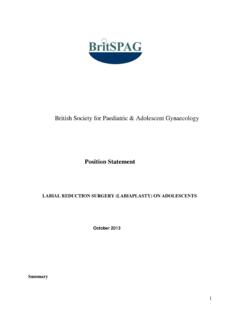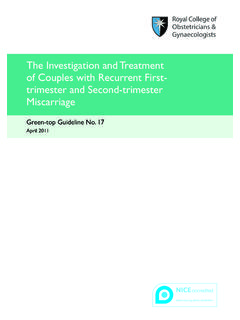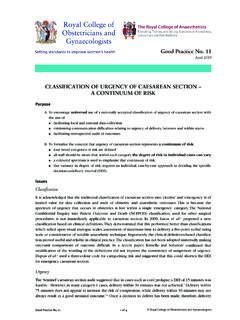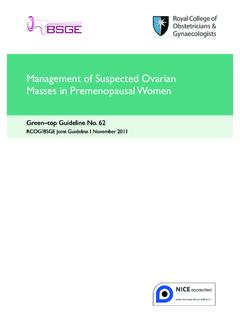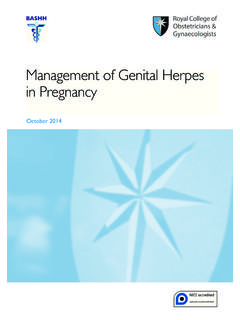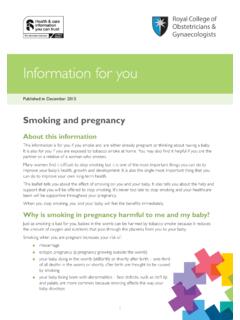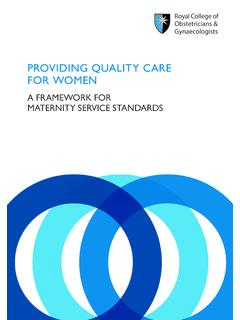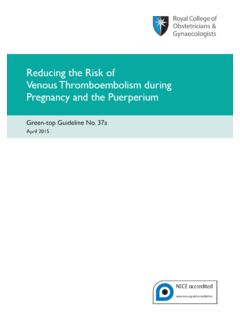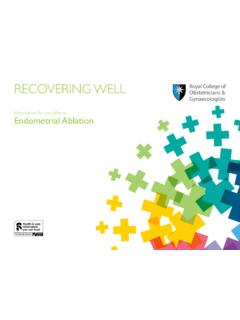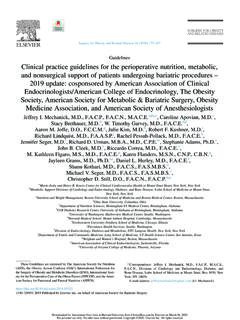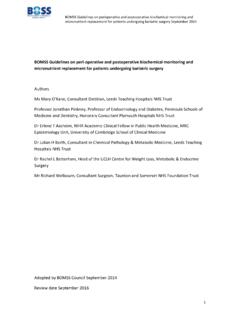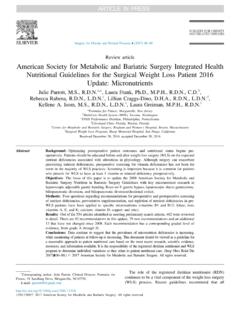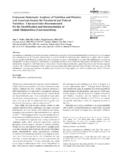Transcription of Long-term Consequences of Polycystic Ovary Syndrome
1 Long-term Consequences of Polycystic Ovary SyndromeGreen-top Guideline No. 33 November 2014 RCOG Green-top Guideline No. 332 of 15 Royal College of Obstetricians and GynaecologistsLong-term Consequences of Polycystic Ovary SyndromeThis is the third edition of this guideline, which was previously published under the same title in 2003 and summary of recommendationsDiagnosisHow is Polycystic Ovary Syndrome (PCOS) diagnosed?PCOS should be diagnosed according to the Rotterdam consensus should women with PCOS be counselled concerning the Long-term implications of their condition andby whom?Women diagnosed with PCOS should be informed of the possible Long-term risks to health that areassociated with their condition by their healthcare consequencesMetabolic Consequences of PCOSWhat is the risk of developing gestational diabetes in women with PCOS?Clinicians may consider offering screening for gestational diabetes to women who have been diagnosedas having PCOS before pregnancy.
2 This should be performed at 24 28 weeks of gestation, with referralto a specialist obstetric diabetic service if abnormalities are should women with PCOS be screened for type II diabetes?Women presenting with PCOS who are overweight (body mass index [BMI] 25 kg/m2) and women withPCOS who are not overweight (BMI <25 kg/m2), but who have additional risk factors such as advancedage (>40 years), personal history of gestational diabetes or family history of type II diabetes, shouldhave a 2-hour post 75 g oral glucose tolerance test women with impaired fasting glucose (fasting plasma glucose level from mmol/l to mmol/l)or impaired glucose tolerance (plasma glucose of mmol/l or more but less than mmol/l after a2-hour oral glucose tolerance test), an oral glucose tolerance test should be performed is the risk of developing sleep apnoea in women with PCOS?Women diagnosed with PCOS should be asked (or their partners asked) about snoring and daytimefatigue/somnolence, informed of the possible risk of sleep apnoea and offered investigation andtreatment when is the risk of developing cardiovascular disease (CVD) in women with PCOS?
3 Clinicians need to be aware that conventional cardiovascular risk calculators have not been validated inwomen with women with PCOS should be assessed for CVD risk by assessing individual CVD risk factors (obesity,lack of physical activity, cigarette smoking, family history of type II diabetes, dyslipidaemia,hypertension, impaired glucose tolerance, type II diabetes) at the time of initial clinical practice, hypertension should be treated; however, lipid-lowering treatment is notrecommended routinely and should only be prescribed by a Royal College of Obstetricians and Gynaecologists3of 15 RCOG Green-top Guideline No. 33 What is the risk of having reduced health-related quality of life in women with PCOS?Psychological issues should be considered in all women with PCOS. Depression and/or anxiety shouldbe routinely screened for and, if present, assessed. If a woman with PCOS is positive on screening,further assessment and appropriate counselling and intervention should be offered by a and PCOSWhat are the risks of cancer in women with PCOS and how should these women be screened?
4 Oligo- or amenorrhoea in women with PCOS may predispose to endometrial hyperplasia and latercarcinoma. It is good practice to recommend treatment with gestogens to induce a withdrawal bleed atleast every 3 to 4 ultrasound should be considered in the absence of withdrawal bleeds or abnormal uterinebleeding. In PCOS, an endometrial thickness of less than 7 mm is unlikely to be thickened endometrium or an endometrial polyp should prompt consideration of endometrial biopsyand/or does not appear to be an association with breast or ovarian cancer and no additional surveillanceis for reduction of riskExercise and weight controlHow should women with PCOS be advised on lifestyle issues?It is recommended that lifestyle changes, including diet, exercise and weight loss, are initiated as thefirst line of treatment for women with PCOS for improvement of Long-term outcomes and should precedeand/or accompany pharmacological drug therapy appropriate for Long-term management of women with PCOS?
5 Insulin-sensitising agents have not been licensed in the UK for use in patients without a body of evidence has accumulated demonstrating the safety of these drugs, there iscurrently no evidence that the use of insulin-sensitising agents confers any Long-term of weight reduction drugs may be helpful in reducing electrocauteryWhat is the prognosis following electrocautery?Ovarian electrocautery should be considered for selected anovulatory patients, especially those with anormal BMI, as an alternative to ovulation surgeryWhat is the prognosis following bariatric surgery ? bariatric surgery may be an option for morbidly obese women with PCOS (BMI of 40 kg/m2or more or 35kg/m2or more with a high-risk obesity-related condition) if standard weight loss strategies have and scopeThis guideline aims to provide information, based on clinical evidence, to assist clinicians who managewomen with Polycystic Ovary Syndrome (PCOS) in advising these women about the Long-term healthconsequences of the Syndrome .
6 The advice should be targeted to the individual and the presentingcomplaints. The delivery of the advice in this document to the patient will need to be done sensitively withinthe framework of the patient presentation that will differ for each individual. This guideline does not coverinfertility associated with PCOS, which has been extensively reviewed ,22. Introduction and background epidemiologyPCOS is a common disorder, often complicated by chronic anovulatory infertility and hyperandrogenism withthe clinical manifestations of oligomenorrhoea, hirsutism and ,4 Many women with this condition areobese and have a higher prevalence of impaired glucose tolerance, type II diabetes and sleep apnoea than isobserved in the general exhibit an adverse cardiovascular risk profile, characteristic of thecardiometabolic Syndrome as suggested by a higher reported incidence of hypertension, dyslipidaemia,visceral obesity, insulin resistance and ,6 PCOS is frequently diagnosed by gynaecologistsand it is therefore important that there is a good understanding of the Long-term implications of the diagnosisin order to offer a holistic approach to the disorder.
7 PCOS is one of the most common endocrine disorders in women of reproductive 9 Because ofdifferences in the diagnostic criteria employed, prevalence estimates vary widely, ranging from to as highas 26%.9 14 The prevalence of PCOS when diagnosed by the Rotterdam criteria was over twice that foundwhen the National Institutes of Health (NIH) criteria were used to diagnose prevalence of PCOS may be different according to ethnic background. For example, compared toCaucasians, a higher prevalence is noted among women of south Asian origin, where it presents at a youngerage and has more severe ,163. Identification and assessment of evidenceThis guideline was developed in accordance with standard methodology for producing RCOG Green-topGuidelines. The Cochrane Library (including the Cochrane Database of Systematic Reviews and the Databaseof Abstracts of Reviews of Effects [DARE]), EMBASE, TRIP, MEDLINE and PubMed were searched for relevantrandomised controlled trials (RCTs), systematic reviews and meta-analyses.
8 The search was restricted toarticles published between 2006 and August 2012. The databases were searched using the relevant MedicalSubject Headings (MeSH) terms including all subheadings and this was combined with a keyword search. TheMeSH heading search included Polycystic Ovary Syndrome , metabolic , diabetes , cardiovascular and cancer . The search was limited to humans and the English language. The computer search wascomplemented by hand searching from original references and reviews. Where possible, recommendationsare based on and explicitly linked to the evidence that supports them. Areas lacking evidence are highlightedand annotated as Good Practice Points . 4. How is PCOS diagnosed?PCOS should be diagnosed according to the Rotterdam consensus 1990 NIH preliminary consensus definition has now been replaced by a more recent definitionby the Rotterdam European society of Human Reproduction and Embryology (ESHRE)/AmericanSociety for Reproductive Medicine (ASRM)-Sponsored PCOS Consensus Workshop Rotterdam criteria17have suggested a broader definition for PCOS, with two out of three of the followingcriteria being diagnostic of the condition: 1.
9 Polycystic ovaries (either 12 or more follicles or increased ovarian volume [> 10 cm3])RCOG Green-top Guideline No. 334 of 15 Royal College of Obstetricians and GynaecologistsEvidencelevel 4D5 of 15 RCOG Green-top Guideline No. 33 Royal College of Obstetricians and Gynaecologists2. oligo-ovulation or anovulation3. clinical and/or biochemical signs of should be noted that the diagnosis of PCOS can only be made when other aetiologies for irregular cycles,such as thyroid dysfunction, acromegaly or hyperprolactinaemia, have been excluded if there is clinicalsuspicion. Women with non-Caucasian ethnicity might need different criteria to diagnose features of hyperandrogenism include hirsutism characterised by excess facial and bodyhair and midline hair growth. Although free and total testosterone is used in the diagnosis of PCOS,the recommended baseline biochemical test for hyperandrogenism is free androgen index (totaltestosterone divided by sex hormone binding globulin [SHBG] x 100).
10 19If there are signs ofvirilisation ( deep voice, reduced breast size, increased muscle bulk, clitoral hypertrophy),rapidly progressing hirsutism (less than 1 year between hirsutism being noticed and seekingmedical advice) or high total testosterone levels (greater than 5 nmol/l or more than twice theupper limit of normal reference range), androgen-secreting tumours and late-onset/nonclassicalcongenital adrenal hyperplasia (CAH) should be excluded. 17-hydroxyprogesterone should bemeasured in the follicular phase and will be raised in CAH. However, it is possible to have CAHwithout the testosterone being greater than 5 nmol/l, particularly if the woman is heterozygous forthis condition. Hence measurement of 17-hydroxyprogesterone should be considered if there is ahigh index of suspicion, for example, specific groups such as Ashkenazi Jews or those with a familyhistory of CAH, since the management of CAH is different than that of PCOS.
